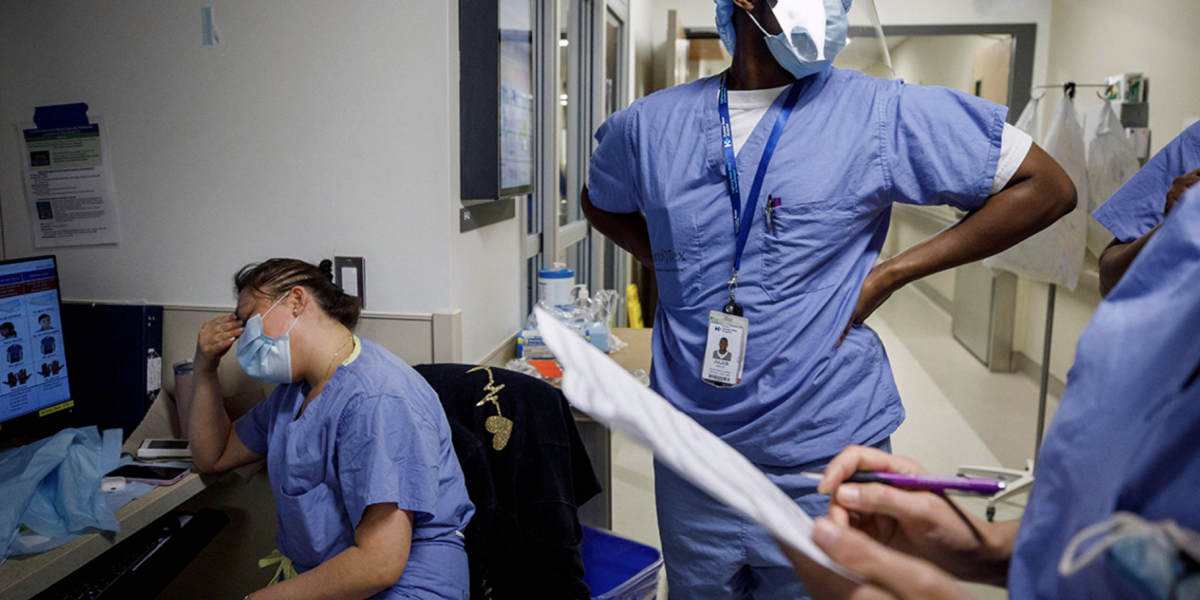The public healthcare system is in crisis, with hospitals that are both overcrowded and understaffed. Governments are pushing privatization but their cure will make the disease worse. The healthcare crisis is a symptom of precarious work—with toxic working conditions that produce illness, low wages that deprive access to treatment, lack of paid sick days that worsen hospital overcrowding, and wage suppression that worsens the nursing shortage. To recover from the healthcare crisis we need to stop further privatization and expand decent work – both as healthy policies and a strategy to win them.
Precarious work makes you sick
The first aspect of the healthcare crisis is massive numbers of people with physical and mental health issues needing treatment—which disproportionately affects low-income and racialized communities. But this is not a simple reflection of biology. As the World Health Organization explained more than a decade before COVID-19, “this unequal distribution of health-damaging experiences is not in any sense a ‘natural’ phenomenon but is the result of a toxic combination of poor social policies and programmes, and bad politics…Social injustice is killing people on a grand scale.”
Precarious work produces illness through low wages, which undermine access to other social determinants of health like healthy food, safe shelter, and a clean environment. Precarious work also has physical and mental health consequences through the nature of work itself: as the World Health Organization explained in the same report, “Mortality is significantly higher among temporary workers compared to permanent workers. Poor mental health outcomes are associated with precarious employment (eg non-fixed term temporary contracts, being employed with no contract, and part-time work.”
Disproportionate rates of COVID-19 were just the latest symptom of precarious work: low-income and racialized communities, with greater rates of chronic illness before the pandemic as a result of toxic inequality, have had higher rates of infection and death from COVID-19. Now the toxic policies from before and during the pandemic have created huge needs for physical and mental healthcare.
Poverty wages deny access to treatment, especially when privatized
The second and related aspect of the healthcare crisis is lack of access to treatment in the community – which results in people ending up in hospital. As the Canadian Medical Association Journal summarized, “prescription drugs, mental health counseling, the bulk of home care, physiotherapy and other services are not consistently publicly insured. Many people with lower incomes cannot afford them and end up in emergency departments and hospital wards with problems that might have been mitigated earlier or prevented altogether.”
In other words, part of the healthcare crisis reflects the combination of low wages and lack of universally accessible public services – neither of which is improved through privatization. We don’t have to guess at what impact privatization will have on healthcare access, because many parts of healthcare are already not publicly and universally provided—like the federal failure to implement national pharmacare or dental care—and this contributes to the healthcare crisis, rather than alleviating it.
Lack of paid sick days worsens hospital overcrowding
The third aspect of the healthcare crisis is the inability to stay home sick or access primary care during working hours, and having to rely on the emergency department for care. Here’s where the lack of paid sick days has a multiplying effect on both increasing rates of illness and reducing access to primary care. Workers without paid sick days (and their children) have lower vaccination rates, are less able to stay home from work/school when sick, and have less access to primary care. So they are more likely to get and transmit infections, and more likely to have to go to the emergency department for care. Workers without paid sick days also include healthcare workers, who are forced to either work sick (and risk infecting their patients and coworkers) or stay home without pay (and risk their own financial security).
This was also seen during the pandemic: low-income and racialized communities had lower rates of COVID-19 vaccination, this gap improved with temporary paid sick days, but then worsened when these were used up and the government refused to legislate permanent and adequate paid sick days. COVID-19 outbreaks were also concentrated in those workplaces that denied paid sick days—from factories and farms to long-term care—resulting in preventable infections and hospitalizations. Now Ford’s few temporary paid sick days are set to expire on March 31, which will worsen the healthcare crisis.
Wage suppression and costly privatization
The fourth aspect of the healthcare crisis is the staffing shortage. This combines wage suppression, precarious work and the denial of paid sick days, and has been used to fuel further privatization. The experience of COVID-19 was a damning indictment the long-term care sector which is built on long-term precarious work, which disproportionately exploits racialized women. As the Canadian National Institute of Aging explained in its report on COVID-19, “Many care providers working in these settings are not offered full-time roles with benefits such as paid sick leave. This has created a necessity for staff to work at multiple jobs across multiple homes, in order to piece together a full-time wage. This sector has traditionally paid its care providers significantly lower wages. These are some of the reasons why there is high staffing turnover in this sector and why the majority of care settings in this sector have struggled with chronic staffing shortages.”
These conditions are worse in for-profit LTC, which had higher mortality rates before and during the pandemic. Yet the response from the Ford government was to reward for-profit LTC with more contracts, and to use their precarious working conditions as a model for the rest of the healthcare system. Bill 124 suppressed the wages of public sector workers throughout the pandemic—including the mainly female workers in nursing. Even the government’s own documents reveal Bill 124 worsened the staffing crisis, but they have used this to fuel precarious work: rather than paying full-time nurses, hospitals have had to spend millions more on temporary agencies who exploit a precariously-employed workforce. This shows how privatization makes a profit, by both suppressing wages and costing more.
This also deliberately ignores not only the lessons of the latest pandemic, but also of SARS from 20 years ago. As the Registered Nurses Association of Ontario explained in 2003, “The experience of SARS has offered all of us a stark reality check: we cannot allow this extreme over-reliance on part-time and casual nursing staff to continue. The nurses who shared recommendations on employment status were very explicit in their call for the need to immediately create more full-time jobs, with appropriate pay, to reduce the need for nurses to seek multiple employers.”
Prescription for health: join the movement for decent work
Privatization is not a solution to the healthcare crisis because it does not address the root of precarious work. Instead, it threatens to worsen the crisis—further suppressing wages, further denying access to treatment, further undermining universal access, and fueling the staffing crisis. Privatization is also being pushed by the same Ontario government that froze the minimum wage, has stubbornly refused to provide adequate paid sick days, and has suppressed the wages of nurses throughout a public health emergency.
On the other hand, decent work provides healthy policies that directly treat the healthcare crisis. Improving working conditions—with permanent, full-time jobs with union protection—promotes both physical and mental health. Raising wages, including with equal pay for equal work, improves access to multiple social determinants of health and goes hand in hand with expanding universal access to public services, which keeps people out of hospital. Legislating 10 permanent and employer-paid sick days for all workers improves vaccination rates, reduces infections in schools and workplaces, expands access to primary care and reduces reliance on ERs. And improving the wages and working conditions of healthcare workers, from hospital to LTC, helps to stabilize the healthcare workforce.
Decent work policies don’t just suggest a healthy and evidence-based alternative to privatization, they also provide a strategy for winning them. The decent work movement forced the Ford government to raise the minimum wage to $15, and to win temporary paid sick days—and pushed the BC and federal governments to make paid sick days permanent. The recent victory against Ford’s Bill 28, through the threat of a general strike and the mobilization of education workers and the broader decent work movement, shows how quickly legislation like Bill 124 could be eliminated.
March 31 marks the expiry of Ford’s paid sick days and the collective agreement of nurses, so it’s urgent to demand 10 permanent and employer-paid sick days as well as decent wages and working conditions for nurses. If the decent work movement can mobilize all workers to improve wages and working conditions, win paid sick days, and support healthcare workers, we could heal from the healthcare crisis and the broader system of precarious work that it represents.
On March 1, join the Decent Work and Health Network’s day of action for paid sick days. On March 2 join the nurses’ protest at the Sheraton Centre in Toronto at 12 p.m.
Did you like this article? Help us produce more like it by donating $1, $2, or $5. Donate

